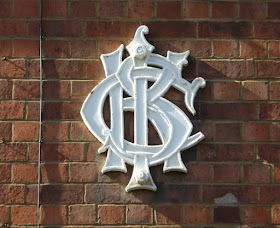Friday, October 2, 2015
Kettering, Northamptonshire
Bake off
I know, I know. I don’t always pick the most obvious destinations for my architectural explorations. A while back, a neighbour of mine actually laughed when I said I wanted to go to Kidderminster, but I enjoyed looking at the carpet factories there nonetheless. The same went for Kettering, where I hoped to find shoe factories but, as usual, I found more than I was expecting.
Tucked away amongst the Victorian red-brick houses and shoe factories, for instance, and hemmed in by white vans and old mattresses, was this Co-operative Bakery. It seems to have been converted to flats, but it’s still a neat example of a medium-sized factory in brick, dating from 1900. It’s lifted above the commonplace with the eye-catching stripy design on the corners and up the walls, by the shallow relieving arches above the windows, and by a couple of stand-out details.
The most obvious of these is the lettering: huge capitals made up out of white tiles. They’ve clearly been specially made – look at the bespoke bits of the B and V – and they leave no doubt about what this building is, or about the Co-op’s pride in it. The other detail is smaller: the graphic devices, in cast iron, set along the side. They spell KICS, for Kettering Industrial Co-operative Society. A lovely touch, on which the raised outlines of the letters catch the sun.
Kettering Industrial Co-operative Society certainly left its architectural mark – there’s a factory and a warehouse in neighbouring streets, too, and its impact was reflected in numerous stores in the town and surrounding villages. And the Kettering Co-op was responsible for at least one major milestone in the story of the Co-operative movement: the town elected the first-ever Co-operative Member of Parliament, in 1918. If a lot of these buildings no longer fulfil their original function, their design very effectively reminds us of their history – and made my journey more than worthwhile.



As a young auditor based in Kettering at the time, I visited a number of shoe factories in the streets of Kettering where as you say they are surrounded by red brick terraces. At one factory we were put in a room which was lined by shelves for samples. Some of these were from WWII and included a dispatch riders boot which was beautifully made as was the boot for flight crew with a tube attached for hot air to stop the feet from freezing at altitude.
ReplyDeleteLike many things most of the industry has gone undermined by cheap imports. Only a few of the handmade shoe manufacturers survive.
I am delighted the town elected the first-ever Co-operative Member of Parliament, and better still, it was in 1918. This must have been a huge victory in the story of the Co-operative movement. Young men had been slaughtered all over Europe and here was a victory for a more moral society.
ReplyDeleteStephen: Yes. I noticed only one or two functioning shoe factories in the town, notably Loake's, who still make excellent shoes.
ReplyDeleteHels: Yes: it was very much part of the opening up of this side of politics in the post-WW1 period - both for the general reason you suggest and because the Co-op and its members had made a very clear stand against wartime profiteering. A handful of Co-operative Party MPs were elected in the 1920s. At the end of that decade they decided to make an electoral agreement with the Labour Party, so that the two parties do not compete in elections. So Co-operative candidates stood as Labour Co-operative MPs, and there are still a number of these MPs, who are members of the Labour Party but who uphold Co-operative values.
ReplyDeleteIn the late fifties I was foistered on an aunt and uncle in Wellingborough whilst my parents had a break from me. Presumably. Uncle John delivered paint and wallpaper around the county in a grey Bedford van for a decorators' wholesale firm. Each box of paint and stuff was often marked 'KICS' 'WICS' 'BLICS' etc. It took me sometime to realise (perhaps by the time we got to Burton Latimer) that the 'ICS' bit was 'Industrial Co-operative Society'. Dear old Uncle John taight me much, including how to drive down a country lane. Not bad considering I was 10 years old and it was a column gear change.
ReplyDeletePeter: Was it one of those vans with sliding doors that made that distinctive sound, so familiar in the 1960s?
ReplyDeleteBy the way, Pevsner seems not to have worked out what 'KICS' stands for. The most recent edition of Northamptonshire says the building has initials indicating 'Kettering Co-operative Society', missing the I somehow.
That was the van. Unmistakeable sliding doors, and quickly made into the ubiquitous Dormobile.
ReplyDeleteAh yes, the sound of those doors is unforgettable. I remember a relative of mine hiring a battered old one, some time in the 1970s, for a particular task. The thing was the worse for wear (I recall that we discovered how a couple of holes in the bodywork had been filled with concrete!) but it went like the clappers, seemed indestructible, even if the doors took a really big pull to haul closed.
ReplyDelete